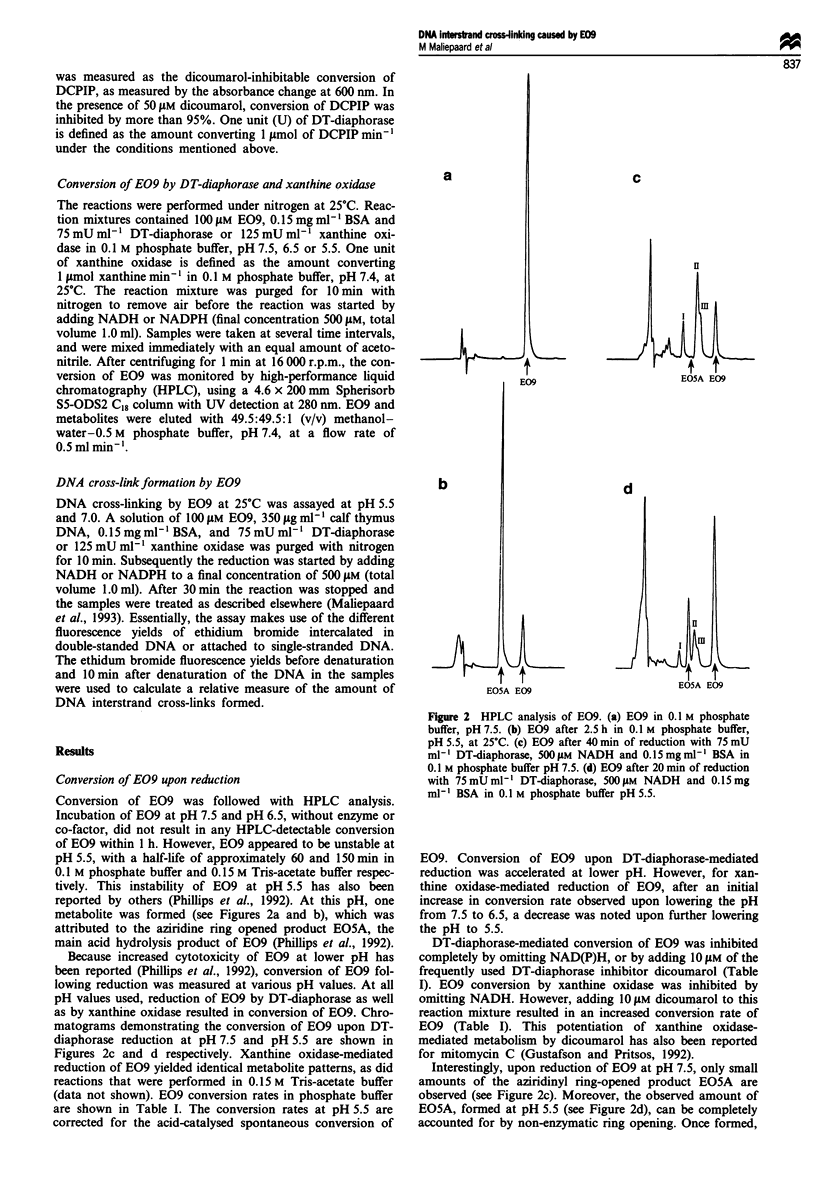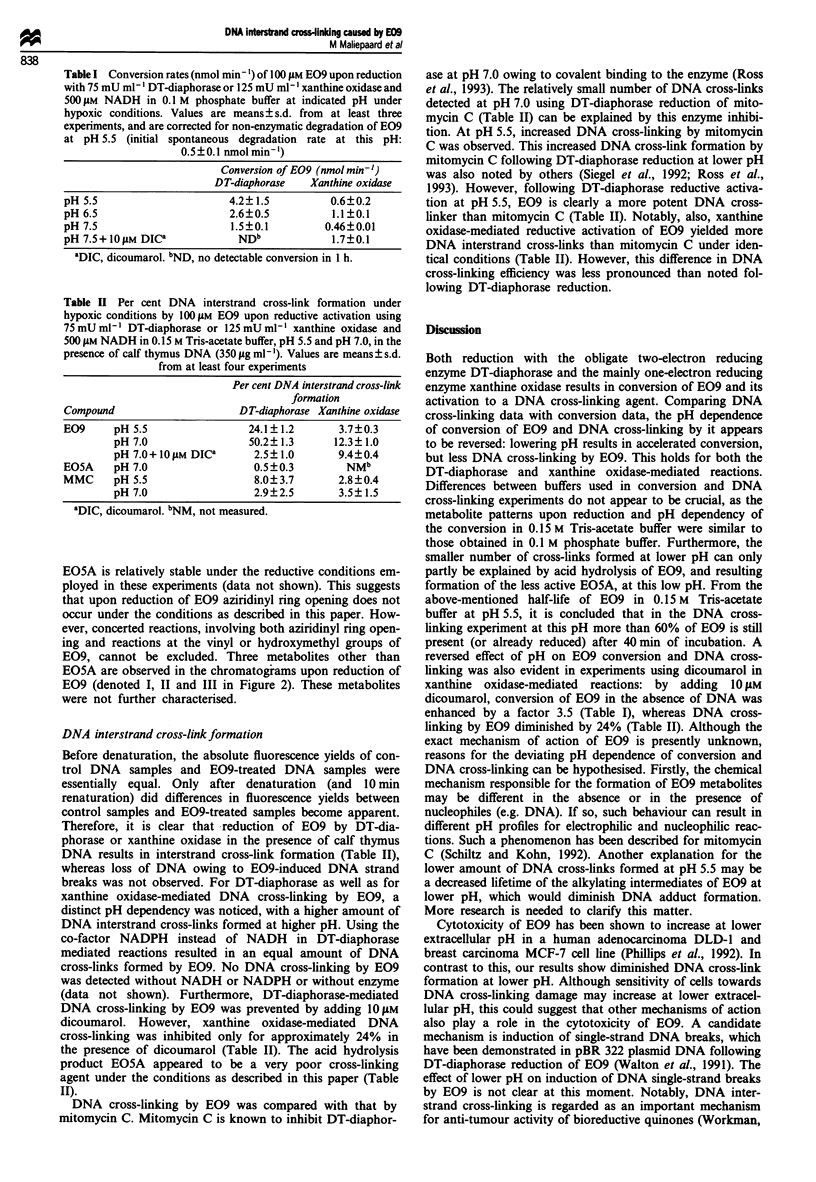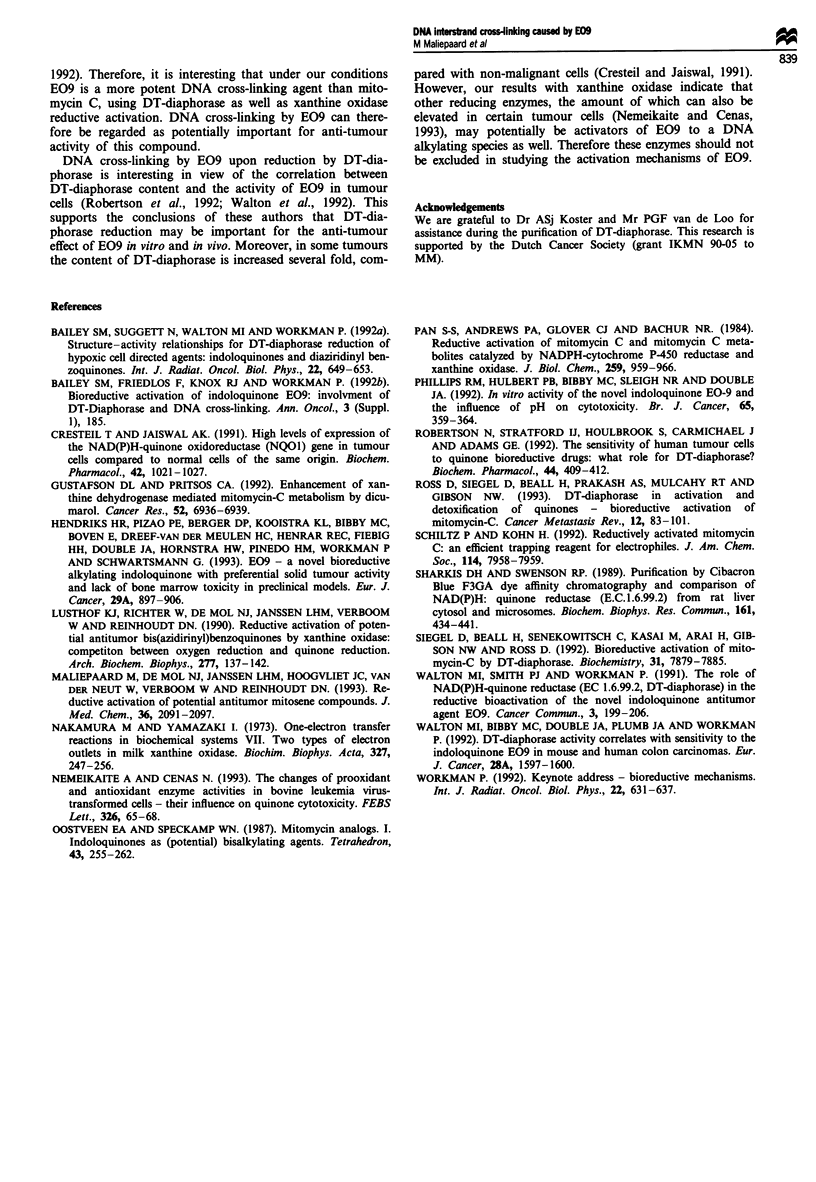Abstract
We report DNA interstrand cross-linking caused by the anti-tumour indoloquinone EO9 following reductive activation with purified rat liver DT-diaphorase or xanthine oxidase. Reduction was a necessary event for cross-linking to occur. DNA cross-link formation by EO9 following DT-diaphorase reduction was completely inhibited by addition 10 microM dicoumarol, whereas only a minor effect of dicoumarol on xanthine oxidase-mediated DNA cross-linking by EO9 was observed. DNA cross-linking was pH dependent, with increasing cross-link formation from pH 5.5 to 7.0 for both DT-diaphorase and xanthine oxidase mediated reactions. Also, conversion of EO9 upon reduction was pH dependent. However, in contrast to DNA cross-linking, conversion rates of EO9 decreased at higher pH. EO9 was shown to be more efficient in DNA cross-linking than mitomycin C under identical conditions, using both DT-diaphorase and xanthine oxidase reductive activation at pH 5.5 and 7.0. This study indicates that the anti-tumour activity of EO9 may be at least partly mediated by interstrand DNA cross-link formation, and that various reducing enzymes may be important for activation of EO9 in vitro and in vivo.
Full text
PDF



Selected References
These references are in PubMed. This may not be the complete list of references from this article.
- Bailey S. M., Suggett N., Walton M. I., Workman P. Structure-activity relationships for DT-diaphorase reduction of hypoxic cell directed agents: indoloquinones and diaziridinyl benzoquinones. Int J Radiat Oncol Biol Phys. 1992;22(4):649–653. doi: 10.1016/0360-3016(92)90496-5. [DOI] [PubMed] [Google Scholar]
- Cresteil T., Jaiswal A. K. High levels of expression of the NAD(P)H:quinone oxidoreductase (NQO1) gene in tumor cells compared to normal cells of the same origin. Biochem Pharmacol. 1991 Aug 8;42(5):1021–1027. doi: 10.1016/0006-2952(91)90284-c. [DOI] [PubMed] [Google Scholar]
- Gustafson D. L., Pritsos C. A. Enhancement of xanthine dehydrogenase mediated mitomycin C metabolism by dicumarol. Cancer Res. 1992 Dec 15;52(24):6936–6939. [PubMed] [Google Scholar]
- Hendriks H. R., Pizao P. E., Berger D. P., Kooistra K. L., Bibby M. C., Boven E., Dreef-van der Meulen H. C., Henrar R. E., Fiebig H. H., Double J. A. EO9: a novel bioreductive alkylating indoloquinone with preferential solid tumour activity and lack of bone marrow toxicity in preclinical models. Eur J Cancer. 1993;29A(6):897–906. doi: 10.1016/s0959-8049(05)80434-4. [DOI] [PubMed] [Google Scholar]
- Lusthof K. J., Richter W., de Mol N. J., Janssen L. H., Verboom W., Reinhoudt D. N. Reductive activation of potential antitumor bis(aziridinyl)benzoquinones by xanthine oxidase: competition between oxygen reduction and quinone reduction. Arch Biochem Biophys. 1990 Feb 15;277(1):137–142. doi: 10.1016/0003-9861(90)90561-c. [DOI] [PubMed] [Google Scholar]
- Maliepaard M., de Mol N. J., Janssen L. H., Hoogvliet J. C., van der Neut W., Verboom W., Reinhoudt D. N. Reductive activation of potential antitumor mitosene compounds. J Med Chem. 1993 Jul 23;36(15):2091–2097. doi: 10.1021/jm00067a006. [DOI] [PubMed] [Google Scholar]
- Nakamura M., Yamazaki I. One-electron transfer reactions in biochemical systems. VII. Two types of electron outlets in milk xanthine oxidase. Biochim Biophys Acta. 1973 Dec 19;327(2):247–256. doi: 10.1016/0005-2744(73)90407-5. [DOI] [PubMed] [Google Scholar]
- Nemeikaite A., Cenas N. The changes of prooxidant and antioxidant enzyme activities in bovine leukemia virus-transformed cells. Their influence on quinone cytotoxicity. FEBS Lett. 1993 Jul 12;326(1-3):65–68. doi: 10.1016/0014-5793(93)81762-o. [DOI] [PubMed] [Google Scholar]
- Pan S. S., Andrews P. A., Glover C. J., Bachur N. R. Reductive activation of mitomycin C and mitomycin C metabolites catalyzed by NADPH-cytochrome P-450 reductase and xanthine oxidase. J Biol Chem. 1984 Jan 25;259(2):959–966. [PubMed] [Google Scholar]
- Phillips R. M., Hulbert P. B., Bibby M. C., Sleigh N. R., Double J. A. In vitro activity of the novel indoloquinone EO-9 and the influence of pH on cytotoxicity. Br J Cancer. 1992 Mar;65(3):359–364. doi: 10.1038/bjc.1992.73. [DOI] [PMC free article] [PubMed] [Google Scholar]
- Robertson N., Stratford I. J., Houlbrook S., Carmichael J., Adams G. E. The sensitivity of human tumour cells to quinone bioreductive drugs: what role for DT-diaphorase? Biochem Pharmacol. 1992 Aug 4;44(3):409–412. doi: 10.1016/0006-2952(92)90429-m. [DOI] [PubMed] [Google Scholar]
- Ross D., Siegel D., Beall H., Prakash A. S., Mulcahy R. T., Gibson N. W. DT-diaphorase in activation and detoxification of quinones. Bioreductive activation of mitomycin C. Cancer Metastasis Rev. 1993 Jun;12(2):83–101. doi: 10.1007/BF00689803. [DOI] [PubMed] [Google Scholar]
- Sharkis D. H., Swenson R. P. Purification by cibacron blue F3GA dye affinity chromatography and comparison of NAD(P)H:quinone reductase (E.C.1.6.99.2) from rat liver cytosol and microsomes. Biochem Biophys Res Commun. 1989 Jun 15;161(2):434–441. doi: 10.1016/0006-291x(89)92617-x. [DOI] [PubMed] [Google Scholar]
- Siegel D., Beall H., Senekowitsch C., Kasai M., Arai H., Gibson N. W., Ross D. Bioreductive activation of mitomycin C by DT-diaphorase. Biochemistry. 1992 Sep 1;31(34):7879–7885. doi: 10.1021/bi00149a019. [DOI] [PubMed] [Google Scholar]
- Walton M. I., Bibby M. C., Double J. A., Plumb J. A., Workman P. DT-diaphorase activity correlates with sensitivity to the indoloquinone EO9 in mouse and human colon carcinomas. Eur J Cancer. 1992;28A(10):1597–1600. doi: 10.1016/0959-8049(92)90049-8. [DOI] [PubMed] [Google Scholar]
- Walton M. I., Smith P. J., Workman P. The role of NAD(P)H: quinone reductase (EC 1.6.99.2, DT-diaphorase) in the reductive bioactivation of the novel indoloquinone antitumor agent EO9. Cancer Commun. 1991 Jul;3(7):199–206. doi: 10.3727/095535491820873164. [DOI] [PubMed] [Google Scholar]
- Workman P. Bioreductive mechanisms. Int J Radiat Oncol Biol Phys. 1992;22(4):631–637. doi: 10.1016/0360-3016(92)90493-2. [DOI] [PubMed] [Google Scholar]


